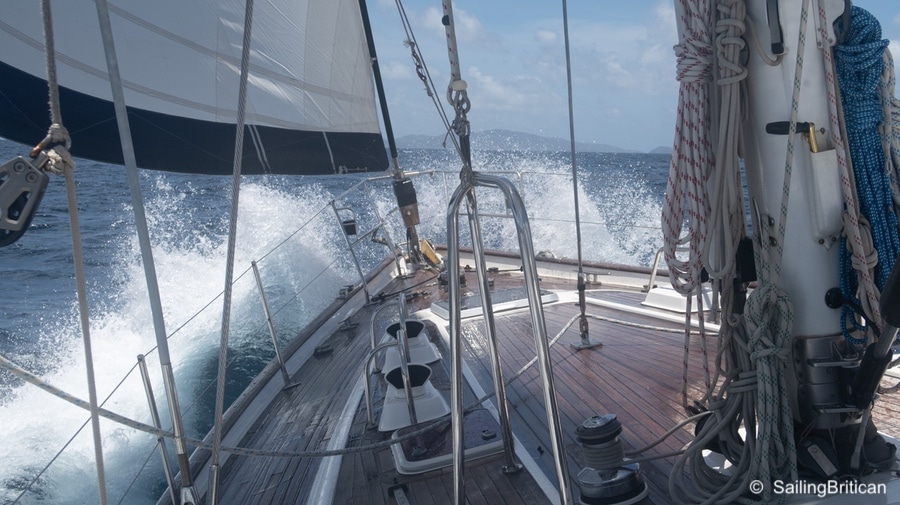You can’t avoid high winds if you’re going to be a sailing cruiser. Squalls and even minor storms pop up unexpectedly. Heck – not long ago a Tropical Storm unexpectedly popped up over the top of us and we had absolutely no warning. So…if you’re going to become a bluewater cruiser it’s important to know high wind sailing techniques.
Watch the video below for a brief introduction to how we handle big winds. The video including how we reef, what we do to spill wind off the mainsail, and how we use our removable staysail. Once you’re done with the video, read more below for further details.
High Wind Sailing Techniques Video
When we get hit with heavy weather or high winds – say above 30 knots, we furl the headsail into the first or second reef. When the weather gets really bad and our headsail is too large for the conditions (even when reefed), we have the ability to furl in the headsail in completely, and then move a stay from the side of the boat up to the front so to use a staysail.
With our rigging configuration, we can essentially turn our boat into a cutter rig. A rig that has two headsails.
The staysail is a smaller sail and can handle heavier weather conditions.
Only if we know there’s going to be high winds, however, do we ever get our staysail out in preparation for high wind sailing techniques. Most of the time, if the wind starts blowing us over to a point where we’re not comfortable we release the main sheet and spill wind off the sail. By ‘spilling’ the wind we reduce the impact of the blow.
Often we don’t reduce our mainsail in squalls as high wind sailing techniques…we just spill when they hit us.
It works so well. But it’s not a common technique that people mention so Simon and I thought we’d mention it.
Join Us To Learn How To Reef, Spill Wind & Fly a Staysail
| THE BRITICAN EXPERIENCE - A WEEK-LONG BLUEWATER CRUISING EXPERIENCE | |
|---|---|
 | During Merrill's Sailing Lifestyle Experience he learned how to book out and into a different country, what it's like to fly a mainsail, genoa, and staysail, how to anchor, tie onto a mooring ball and dock up at a marina. And unfortunately/fortunately Merrill managed to experience what it was like to ride out a surprise tropical storm. If you'd like to experience what it's truly like to live and cruise on a bluewater sailboat, come join me for a week. Check out our availability here: Click here for more information. |
Other Articles/Videos You Might Be Interested In

Any questions?!
Please leave them in the comments below.
Check Out Other Sailing, Maneuvering & Mooring Related Articles and Videos
To get an overview of all our sailing, maneuvering, and mooring related articles and videos, start here: Sailing, Maneuvering & Mooring. Otherwise, check out one of these articles or videos:
- Stern To Med Mooring
- High Wind Sailing Techniques
- How To Tie Onto A Mooring Ball
- How To Leave A Dock
- Anchoring In Poor Holding Anchorages
- Anchoring In Storms
- Anchoring Complications – Picking Up Someone Else’s Anchor
- How To Pole Out Your Jib Downwind Sailing
- Sailing With A Gennaker
- Rigging, Sails & Reefing On A Sailboat
- Sailing Pre-Passage Checklist
I am so impressed by the three of you. Your videos are inspiring and enjoyable. Thank you for sharing your experiences. May the wind be always at your back
Thank you Ernie. We appreciate the feedback 🙂
Hi guys ,
Helena here is a quick comment …..this video is right up my street .Notwithstanding the marvellous sailing matters you bring to me in rainy Glasgow , It is the actual sailing particularly in heavy seas combined with Simon’s narrative about how to employ the sails which gets my undivided attention .
I have no experience in sailing and as an 80 year old woman am unlikely to ; but this business of types and function of sails ,various stays , sheets and pros of say cutter rig over separate stay sail etc is fascinating . I now know why you reef the genoa and how to read reef 1 reef 2 etc and that this arrangement can be inferior to a well set stay sail . Ehhh i think
I took to computers in 2012 and being single i find that you are an extension to my life circle dear Simon , Kim and Sienna . Long may we continue .
Sincerely Helena Hutcheson
Thank you
Hey Helena, what a wonderful comment. Thank you so much. Our next video is about how to take apart a winch, clean it and grease it. I wonder if you’ll enjoy that one too. Hehehehehe. It’s not as cool as sailing techniques but I find it equally fascinating to see what’s inside all these pieces of equipment that we use. May the sun shine on Glasgow! 🙂 Kim
Simon thank you for the excellent video on high wind rigging.
Curtis
Thank you Curtis.